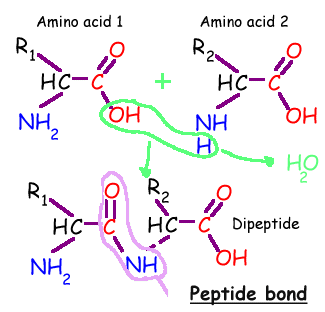What is a Protein??
Proteins are important substances that your cells produce in response to the orders given by the DNA that is present inside a cell. Every day, your cells produce thousands of different proteins to do thousands of different jobs. For example, your pancreas produces a protein known as insulin for your other cells. Your red blood cells produce a protein known as hemoglobin to carry oxygen to different parts of your of body. And the list goes on and on. In this section of Genetics R Us, we are going to take an up close look at proteins, and learn about their important role in sustaining life as we know.

Let’s take a closer look at proteins. Shown toward your left is a typical protein. All proteins are composed of smaller units which are called amino acids. To make it easier for you to understand, you can think of a protein as a string of beads. Like something similar to a necklace that you might wear around your neck, proteins can be thought of as the same.
In nature, there are 20 amino acids. Of the thousands of proteins that exist, they are all made up of 20 simple amino acids. A cell knows what amino acid to connect to one another thru the instructions it receives from DNA. Here’s a diagram of the known amino acids toward your right.



All proteins have a chemical structure that is very important to its existence. The name of that structure is the a peptide bond. Shown toward your left are two amino acids which are joined togther by a peptide bond. The purpose of the peptide bond is to connect two more amino acids.
Every peptide bond is formed when two amino acids are joined together. This reaction takes place when water, H20 is removed. If look in the model toward your left, you can see this. Every peptide bond consists of a single nitrogen (N), hydrogen (H), carbon (C), and oxygen (O) atom.

A Shy Protein
If you ever took a chemistry class, then your chemistry book probably used a lot of “models” to describe what a protein looks like. The same is true for Genetics R Us. Many times I used models to you, so that you would be able to understand the concepts. This is no coincedence. There is a good reason for the use of models in science Here’s why!!!!!

In addition, each of the 20 amino acids may be assigned a single letter from the alphabet. For example, the amino acid, Histidine, is assigned the letter, “H”. This level is where the protein’s primary structure exists. The primary structure gives a protein’s amino acid sequence as well as sulfur bridges. The element sulfur is present in many proteins. When two sulfur atoms connect to each other, they are called a “sulfur bridge”.





With that, we’ll end our discussion on proteins. Proteins represent DNA commands in action. The passing of commands from DNA to the protein can summarized into a neat little equation that you may want to commit to memory. (And remember, all of this takes place inside of the cell).

